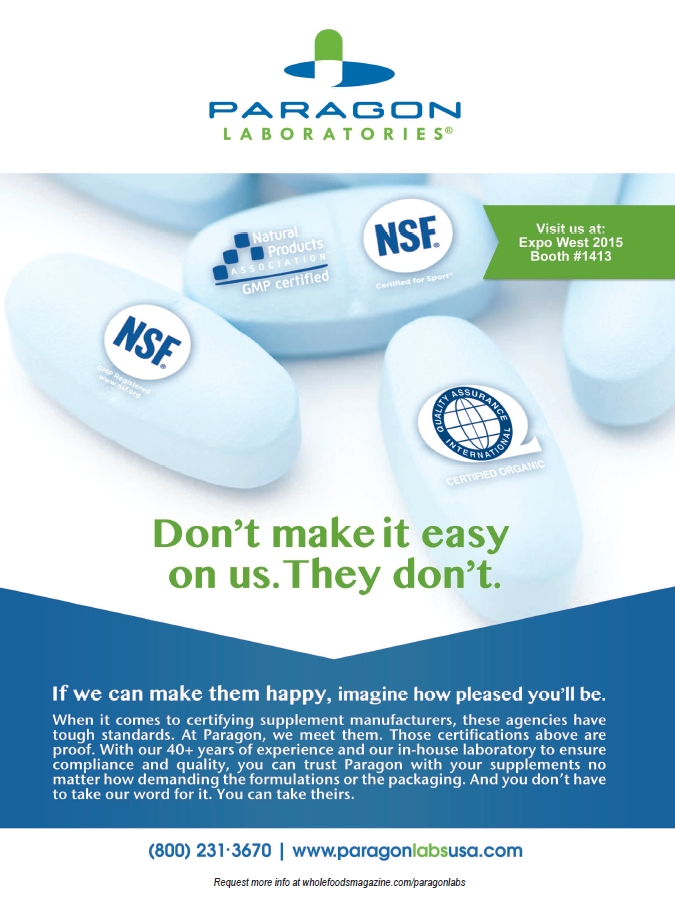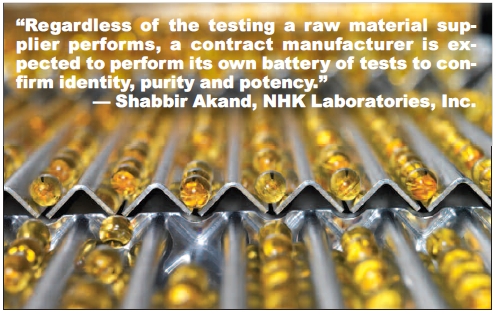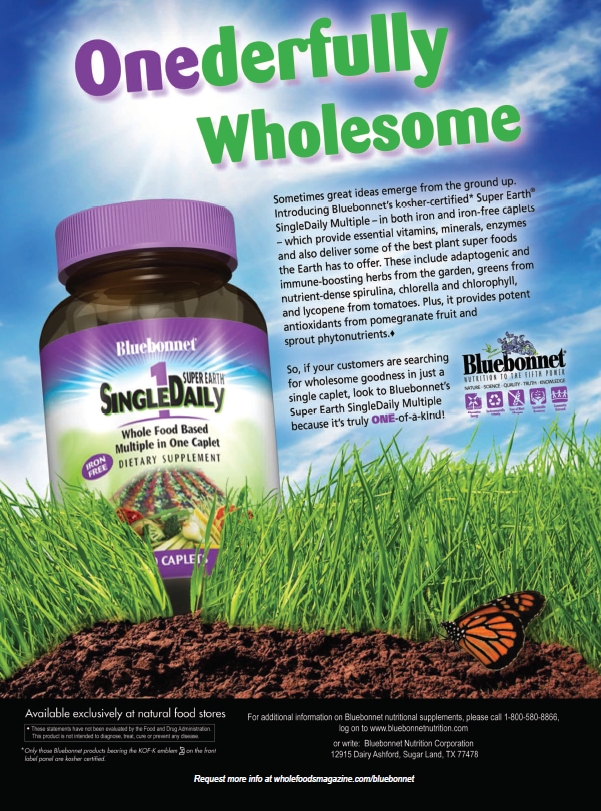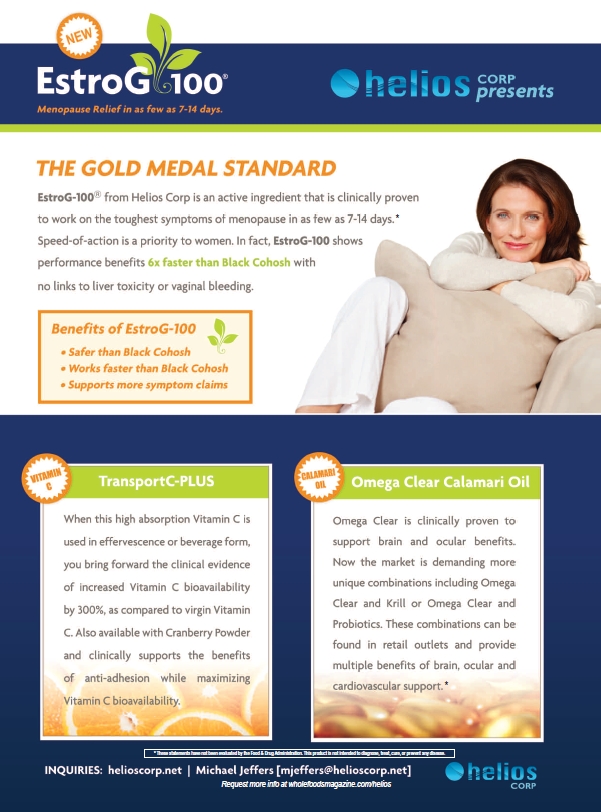To be a competitive contract manufacturer in today’s dietary supplement market, quality is a must. The demands of product marketers and their customers, along with the demands of regulators like the U.S. Food and Drug Administration (FDA), have combined to create a strong movement toward improved standards.
As a result, manufacturers are investing more than ever in expanding their own capabilities and in high-quality product testing. They are also communicating these efforts more consistently to both the product marketers they work with and to regulators. “Change takes time,” says Steve Holtby, president and CEO of Soft Gel Technologies, Inc., Los Angeles, CA, “but the industry as a whole seems to be working diligently to rise to the standard they’ve set for themselves.”
Contract Fundamentals
Some will remember from high school biology that meiosis (as opposed to mitosis) is a cell division process. After it’s complete, the newly formed cells contain half the genetic material of the parent cell. What does this have to do with contract manufacturing, you ask? Well, a similar change has taken place with many of the contracts drawn up today, according to Robin Koon, executive vice president of Best Formulations, City of Industry, CA.
Koon says that as a contract manufacturer, his company sees two types of contracts in common use. One is the Quality Agreement (QA), which spells out who is responsible between the manufacturer and the finished product marketer for certain checks, specifications and the like. Koon explains that FDA now encourages companies to establish a QA with every customer.
The Manufacturing Agreement is separate, and it covers pricing, delivery, terms, liability, insurance and other business angles, Koon says. Previously, he adds, these two contracts were often combined into one. This new division, it would seem, reflects today’s focus on quality through every stage of the contract manufacturing process.
covers pricing, delivery, terms, liability, insurance and other business angles, Koon says. Previously, he adds, these two contracts were often combined into one. This new division, it would seem, reflects today’s focus on quality through every stage of the contract manufacturing process.
The manufacturer and client must also strive for quality in the contract itself. Numerous elements are important to address in a contract, and Richard Kaufman, chief operating officer of Paragon Laboratories, Torrance, CA, names a few for us: detailed finished product specifications, what type of testing will be performed, responsibility for that testing, responsibility for supplying the raw materials and packaging components, responsibility for the various aspects of current good manufacturing practice (cGMP) compliance, who generates and approves the label copy, a bilateral non-disclosure agreement between the parties, the procedure for handling product complaints, and finally, who owns the intellectual property rights associated with the product and its manufacture.
Before ever signing a purchase order or contract, Holtby says potential customers should ask contract manufacturers some key questions. One is whether their operation is FDA cGMP compliant, and if the answer is yes, they should find out who did the certifying. Another key question regards the unexpected. Holtby says that everyone can make a good product when everything goes as planned. But, customers should probe how manufacturers handle any testing issues, raw material shortages or other obstacles that crop up. Holtby’s last suggested query is a simple one: “Can I come today and visit your facility?” He explains that manufacturers should welcome audits from customers, as not only can it be a learning experience for the manufacturer, but it also allows customers to see with their own eyes how things are being done.
Of course, even when the parties involved do their due diligence in many of these areas, missteps can still be made. Some of these can be avoided by properly balancing price against quality and setting clear expectations, according to Elan Sudberg, CEO of Alkemist Labs, Costa Mesa, CA. From product recall examples like melamine in infant formula and lead in the paint on children’s toys, Sudberg says we’ve learned that you get what you pay for. Blaming the source, such as China, sidesteps the real issues, which he feels are complacency and, sometimes, a profit-centric mindset. He points out that in the effort to save money, corners are often cut.
This also applies to the dietary supplement industry, Sudberg argues, in that product marketers need to make sure they are clear on the specifications for each and every ingredient that goes into a final product. Subpar testing and ingredient sourcing can result when price point becomes the sole focus for marketers. “On the contrary, if the desire is to produce a ‘top shelf’ product, the product marketer must specify exactly that,” Sudberg says. The result in these cases, he explains, will be the use of the highest quality ingredients, tested by reputable labs, with full disclosure of test methods.
 Any pricing variability is important to address in the initial contract, Koon says. The often unpredictable changes in the costs of raw materials should be accounted for beforehand, as they impact the final cost of products even though they are outside a manufacturer’s control.
Any pricing variability is important to address in the initial contract, Koon says. The often unpredictable changes in the costs of raw materials should be accounted for beforehand, as they impact the final cost of products even though they are outside a manufacturer’s control.
Matt Mielke, quality manager for UAS Labs, Madison, WI, cautions marketers about another issue. “There are many elements to be covered in a contract, but labels are an area where I see the most confusion and the biggest liability gap,” he says. A contract should spell out who is responsible for label content. According to Mielke, this includes how labels are to be revised and who pays for their revision, how label security is maintained and who is responsible for obsolete labels. He explains that disposal of labels isn’t as simple as tossing them in the garbage; secure disposal is required. “These tend to be surprise costs that aren’t covered in the margin,” he says.
From the manufacturer’s perspective, a lot can be accomplished by having good communication practices in place. Ryan Fisher, general manager of Trace Minerals Research, Ogden, UT, says that over the years he’s learned the importance of having educated sales representatives. “Sales people who have a good understanding of the contract can usually give solid explanations during the sales process as to what customers can expect after the sale and during the course of the contract, avoiding surprises.” Addressing, for instance, what will be done in cases where unsatisfactory products are produced, as well as other issues like exclusivity minimums, trademarks and territories, can help prevent problems down the road.
Test Patterns
Advancements in testing methods and equipment are at the core of the movement toward quality, whether the investment is taking place at third-party laboratories or in-house facilities. Many of these technologies are exciting to the people who work with them, says Sudberg. But he adds that some of the more recent methods to come about promise ease of use and require no technical training. This often seems a bit too simple, he feels, and when it comes to ingredient testing methods, Sudberg advocates those that are “fit for purpose.”
In botanical ingredient identification, he says that  high-performance thin layer chromatography (HPTLC) is a clear winner, having been perfected over the course of 100 years. When it comes to measuring compounds, gas chromatography, high-performance liquid chromatography (HPLC) and related tests are the best options, Sudberg says. “Why mess with something that works, has been time tested and is globally accepted?” he asks.
high-performance thin layer chromatography (HPTLC) is a clear winner, having been perfected over the course of 100 years. When it comes to measuring compounds, gas chromatography, high-performance liquid chromatography (HPLC) and related tests are the best options, Sudberg says. “Why mess with something that works, has been time tested and is globally accepted?” he asks.
A shift away from certain methods, such as Fourier transform infrared spectroscopy (FTIR), is taking place in some contexts, observes Koon. “We are seeing significant change in the way botanical raw materials are being tested. The FDA has indicated to the industry that the use of FTIR as a laboratory ID test is being phased out,” he says. This particular test is not equipped to properly identify a specific plant species, he explains, but many manufacturers still use it. He says his company has switched to HPLC or HPTLC testing for botanical products, and notes that while they are more expensive, they are also more accurate.
Also, while instrumentation and methods keep improving, Mielke says that not all methods are validated for their intended use from the get-go. “This is an important step to ensure that the data is meaningful and will stand up to scrutiny,” he says. Mielke believes method validation (i.e., the task of making sure an analysis reliably delivers the information it is supposed to) will be the next major trend in the field of testing.
 Making tests more robust and creating standards is an ongoing process. “Analysts are developing a better understanding of what can be tested for, and further, what limitations may exist as to the accuracy of a particular test method, as it applies to a raw material or a multiple ingredient blend,” Kaufman says. Labs are working hard, according to Fisher, to develop testing methods for more complex, multiple-ingredient blends. But they continue to face road blocks, and developing these new methods costs both time and substantial amounts of money. To develop and implement proprietary testing methods for the ingredients they use, Fisher explains that contract manufacturers must often make a significant investment.
Making tests more robust and creating standards is an ongoing process. “Analysts are developing a better understanding of what can be tested for, and further, what limitations may exist as to the accuracy of a particular test method, as it applies to a raw material or a multiple ingredient blend,” Kaufman says. Labs are working hard, according to Fisher, to develop testing methods for more complex, multiple-ingredient blends. But they continue to face road blocks, and developing these new methods costs both time and substantial amounts of money. To develop and implement proprietary testing methods for the ingredients they use, Fisher explains that contract manufacturers must often make a significant investment.
Division of responsibility. Though the basic requirements for testing are clear enough, exactly who is meant to perform these tests, and when, is left somewhat unclear by FDA regulations. This is why each leg of the supply chain, from supplier to manufacturer to marketer, must work together to ensure that the testing and record keeping is up to par, or else gaps can occur and warning letters can ensue.
Contract manufacturers take on much of the burden. “Regardless of the testing a raw material supplier performs, a contract manufacturer is expected to perform its own battery of tests to confirm identity, purity and potency,” says Shabbir Akand, vice president of sales and marketing at NHK Laboratories, Inc., Santa Fe Springs, CA.
Mielke says the manufacturer typically shoulders the responsibility for testing both the raw materials and the finished products. Then, product marketers usually want to see these results for their own assurance. “Most contract customers expect the testing to be rolled into a turnkey price,” Mielke says. They may, he adds, specify what testing they want done, but the contract manufacturer is left to determine the methods, lab, sampling and other particulars. Selecting the most appropriate method for the ingredients involved and the right lab to perform tests is an important process.
Some manufacturers continue to rely heavily on the raw material supplier’s stated results on the certificate of analysis (COA). “However,” Holtby says, “it is vital that contract manufacturers develop their own protocol for testing and qualifying individual batches of raw materials, as they carry a good chunk of end product responsibility.”
Like it or not, manufacturers find themselves in this position of responsibility by default. “Contract manufacturers almost have to do all the testing themselves. We have found that it can be cumbersome to go out and qualify suppliers, and that in many cases it is easier to just do all the testing on the raw materials and qualify the material,” says Fisher. Koon says his company makes sure that the materials it uses conform to both the supplier’s COA and the company’s own in-house specifications.
Though contract manufacturers usually  perform testing at every stage of the product’s manufacture, Kaufman says that marketers may still choose to perform their own testing to ensure that finished product specifications are being met.
perform testing at every stage of the product’s manufacture, Kaufman says that marketers may still choose to perform their own testing to ensure that finished product specifications are being met.
Holtby adds that if a customer plans to audit its manufacturer, they should do so on a timetable consistent with their buying habits. They should ask for batch records, COAs and, most importantly, make sure that all cGMP-required testing is being done. Holtby says to keep in mind that some manufacturers may look to save money by skipping out on testing. “If a quotation looks too good to be true, there is probably is a reason,” he says.
To be sure, the level and quality of testing varies throughout the industry. “In my experience, this depends a lot on the contract manufacturer chosen and more specifically on how much you want to pay for your ingredients,” says Sudberg. Good ingredients are expensive, he says. Good ingredients that are internally tested and come with a COA and full method disclosure are yet more expensive. Finally, good ingredients that are tested by a third-party lab cost more still.
FDA focus. A clear division of testing responsibility between manufacturer and client is especially important in light of FDA’s requirements, Kaufman explains. The agency expects specifications to be confirmed by testing at every stage from raw material to finished product. “One can readily go to the FDA’s Web site and view warning letters issued to companies where they have failed to perform this type of testing,” Kaufman says. A plan for what type of testing will be performed and by whom is therefore helpful in avoiding any problems. Kaufman says that to ensure proper testing is taking place, marketers can contract with GMP-certified manufacturers that are audited on a routine basis by independent third-party groups like NSF.
The main regulatory focus of FDA is on potency and identification, says Holtby. Akand adds that microbe testing is also a key focus area. He says the industry may be falling short in testing for certain types of adulterants and contamination, including tests for pesticide and solvent residues, heavy metals and ingredient spiking.
Identity testing is at once the most difficult analysis to perform and the easiest test for FDA to scrutinize, Mielke says. While many companies still use FTIR as an identification method, he says it won’t work on mixtures, probiotics, flavors, enzymes or anything that is not a pure compound. “Identity testing must be applicable to the material being analyzed and there is no one single technique that will work for every material out there,” Mielke says.
 “The FDA has made it clear in its cGMPs to use methods to verify ingredients that are scientifically valid. Unfortunately, this has given lots of wiggle room for cloudy interpretation on what is scientifically valid and what is not,” says Sudberg. He notes that his company frequently fails materials that it tests through HPTLC that have passed when run through other testing methods. This reveals that in at least some cases, technology is being improperly used, which he says is a disservice to the overall quality the industry can provide to consumers. If manufacturers became more transparent about what labs do their testing, Sudberg says it would go a long way, because there are labs with reputations for doing good, reliable work, and others with lesser records.
“The FDA has made it clear in its cGMPs to use methods to verify ingredients that are scientifically valid. Unfortunately, this has given lots of wiggle room for cloudy interpretation on what is scientifically valid and what is not,” says Sudberg. He notes that his company frequently fails materials that it tests through HPTLC that have passed when run through other testing methods. This reveals that in at least some cases, technology is being improperly used, which he says is a disservice to the overall quality the industry can provide to consumers. If manufacturers became more transparent about what labs do their testing, Sudberg says it would go a long way, because there are labs with reputations for doing good, reliable work, and others with lesser records.
The microbial testing required by FDA is rather straightforward to perform, Koon says. “It is the testing of nutritional ingredients that is a difficult area, since many of the materials do not have industry test standards,” he says. When possible, he says his company uses testing standards from compendia sources like The United States Pharmacopeial Convention and the Council for Responsible Nutrition. Other times, he says companies like his develop their own methods, often with help from the supplier.
Testing as a selling point. “For any marketer interested in a quality finished product, it behooves them to understand the importance of testing as well as what types of tests will be performed, in order to assure that the finished product specifications are being met,” says Kaufman. Given this interest on the part of most marketers, it stands to reason that manufacturers will use their testing standards to entice clients.
A manufacturer that effectively communicates and is open about its procedures becomes a more attractive partner for marketers, as it reduces guesswork and liability, Holtby says. Often, test results for a variety of compounds are stated on the COA of every product batch. Test methods are also frequently indicated, he says, and more marketers are now documenting their own requirements for testing protocols.
Some manufacturers use third-party certifications to convey the level of testing they perform, says Fisher, and this may be used as a minor selling point. Third-party certification is expensive and can add significant costs to finished products, making them less competitive as options for consumers. But Fisher believes that quality will ultimately win. “Companies holding themselves to high testing standards create a better product which in return makes consumers continue to buy the product and builds trust in the brand,” he says.
One difficulty with maintaining high testing standards is that manufacturers must source materials that will consistently meet those standards, Mielke points out. Higher standards will yield more test failures and more rejected materials. “When this happens, replacement material must be sourced and testing starts all over again,” he says.
The lines of communication on product testing often begin with marketers asking questions, according to Mielke. This is because many consumers expect high standards and are looking for products that meet their expectations. “The hard part is figuring out market share per  unit cost,” he says. In other words, what are consumers willing to pay for in a product claim? Will additional testing get consumers to switch brands?
unit cost,” he says. In other words, what are consumers willing to pay for in a product claim? Will additional testing get consumers to switch brands?
Sudberg thinks more can be done in the way of using testing standards as part of consumer marketing. “We consult publically shared safety ratings before we buy a car. You can actually download videos of crash tests before you make your final decision,” he says. But in the dietary supplement industry, he sees little marketing of quality control down to the consumer level. In addition to being interested in the health benefits of that new, hot phytochemical, consumers are also interested in its safety. Sudberg thinks companies can benefit by emphasizing their quality and testing programs to consumers, including on product labels. He says, “It’s time to tell your consumers why the contract analytical lab business is growing; it’s because companies are spending millions a year on the behind-the-scenes, mission-critical factor called quality control.”
While testing standards can be an effective means of impressing marketers and consumers, Akand stresses that the main reason for maintaining high standards is a duty to provide safe and effective products. He says that less than half of Americans regularly take a prescription drug, but most Americans take dietary supplements on a daily basis. “We feel this places an important responsibility on the shoulders of contract manufacturers,” says Akand. More than a selling point, product testing is an obligation. WF
See www.wholefoodsmagazine.com/suppliers for additional coverage of the supplier category.
Published in WholeFoods Magazine, January 2015









